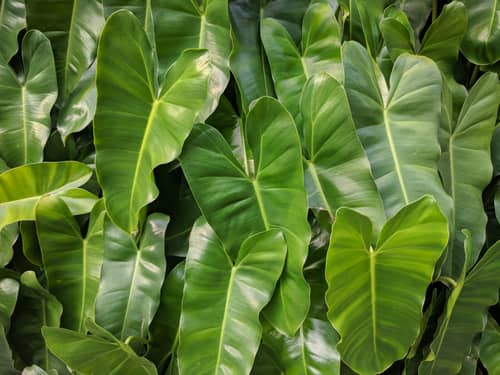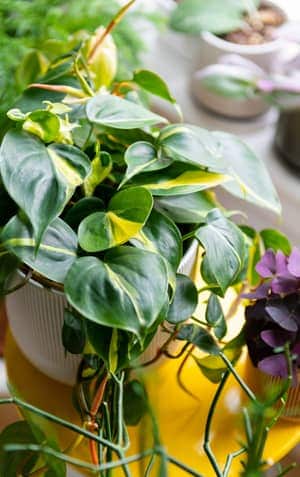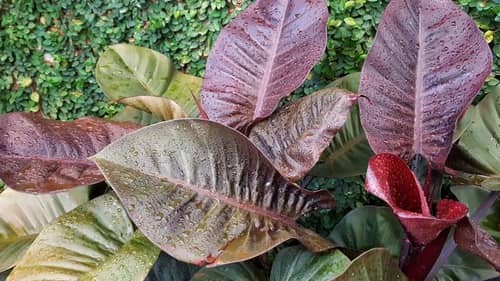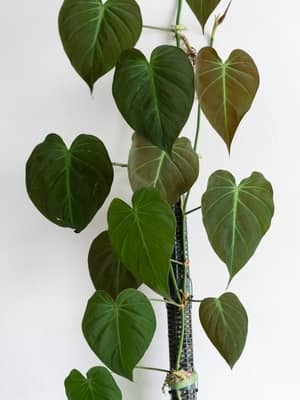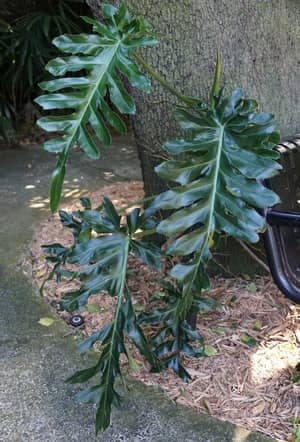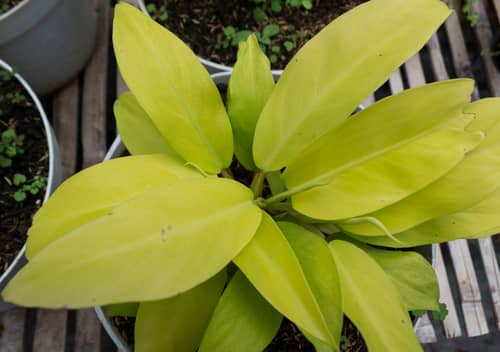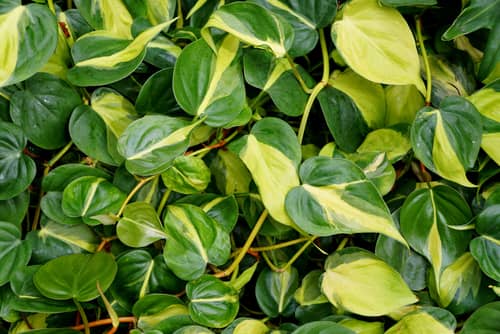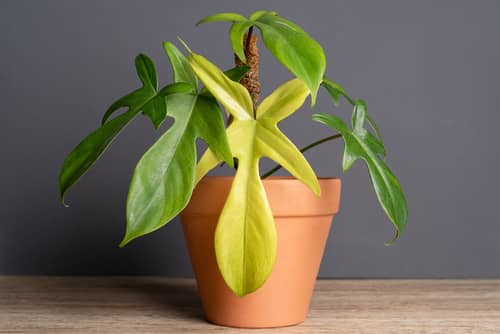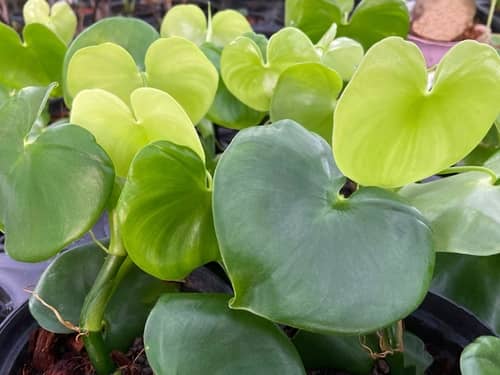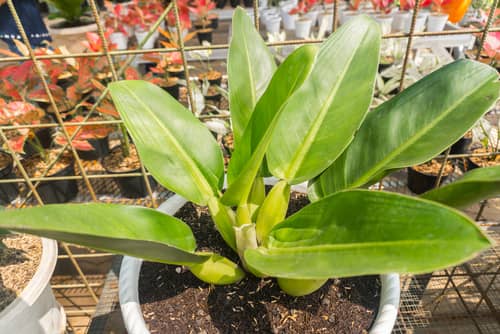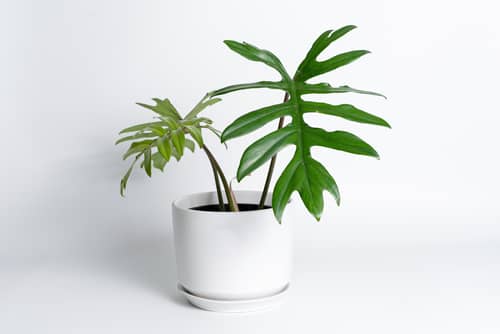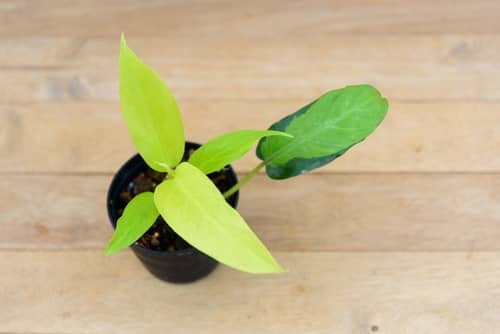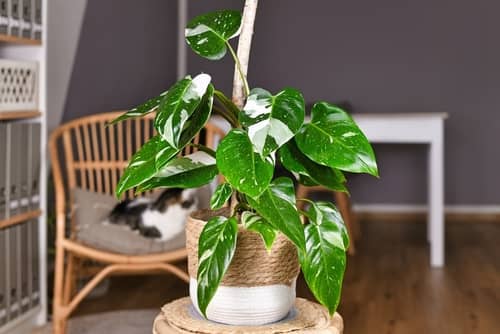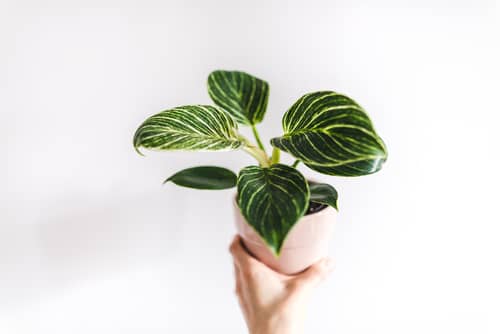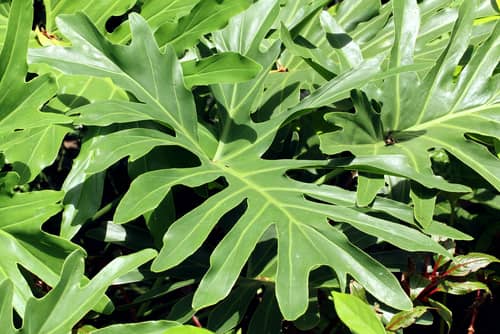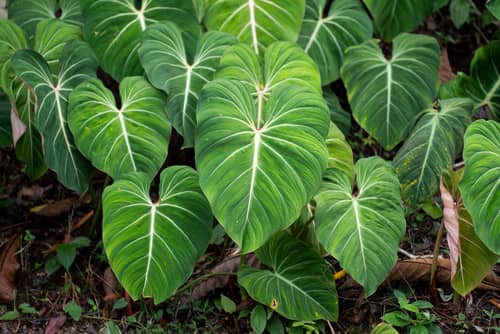Few plants have swept the world by storm as dramatically as the Philodendron. This tropical plant family is as diverse as it is intriguing.
With names such as Pink Princess, White Wizard, and Xanadu, you know you’re in for some plant pageantry.
It doesn’t matter where you are in the plant expertise ladder — whether you’re a beginning plant parent, a gardening enthusiast, or a top-tier plant collector, you’re bound to fall for the Philodendron’s spell.
What is a Philodendron?
What makes Philodendrons so phenomenal? Philodendron varieties are popular the world over because of their beautiful foliage and easy-to-care for status.
Their traits are telltale of their tree-hugging nature (roughly translated, ‘Philodendron’ means ‘tree-loving’ in Greek) and South American roots.
Philodendrons absolutely love warm, humid climates. No surprise there as the rainforest is their natural habitat.
Give your Philodendron plenty of moisture and bright, indirect sunlight, some plant food, and you’ll have a thriving houseplant with lush leaves in no time.
Philodendrons are famous for their versatility as well. You can grow them in a pot indoors or a garden plot outdoors. They can adapt as long as you use well-draining soil — that, and plenty of moisture in the air.
The good news is, there’s so much more to do than good old gardening when you’re caring for a Philodendron.
Aside from their bold, verdant foliage, Philodendrons are hailed in plant collecting circles for their air-purifying properties.
They’re also marvellous as ground covers. With a few fast-growing Philodendrons here and there, you can finally say goodbye to bald spots in your garden.
When you’re a Philodendron plant parent, you’ll find that the benefits just keep on multiplying.
You can even turn your frond fixation into a profitable hobby — most Philodendron types are easy to grow and can be quickly propagated through cuttings.
Which Philodendron is right for you?
In the Philodendron world, fascinating characters flourish. Larger-than-life personalities, gentle giants, and fresh air benefactors populate the whole amalgam of the Philodendron family.
You’ll also find low-key wallflowers here, but they’re few and far in between.
With a merry mix of ornamentals at your fingertips, how do you know which type is right for you?
To help you decide, we’ve compiled a quick guide for you.
Colour
Thinking of sprucing up your interiors? A Philodendron’s bright green foliage will add a fresh splash of colour to a blank wall or empty corner in your home.
If the usual green is too predictable for you, there are other more flamboyant varieties that may tickle your fancy.
Decorate your home instead with a Philodendron Pink Princess, White Knight, White Wizard or Prince Albert.
Variegations in crimson, lime, golden yellow, white, or bubblegum pink are these varieties’ claim to fame.
Size
Philodendrons come in a wide range of sizes.
From tiny potted varieties to supersized tree-like types, you’re sure to find one that meets your needs.
Nature of growth
Another factor to consider when deciding which Philodendron to pick is your plant’s growth nature. Philodendrons come in both self-heading and climbing varieties.
Self-heading varieties are what we like to call the prim and proper Philodendrons of the bunch. These types are upright growers and don’t need structural support at all.
Self-headers are no slouchers. They’re known for their majestic stance and contained growth patterns.
Climbing types are generally fast growers and can quickly cover bare spaces. These varieties need structural support to aid their vertical growth.
Leave them unpruned and unaided by support and you just might find a replica of a South American rainforest crawling in your home.
The voracious vining type of growth may not be for everyone, but if you’re going for the wild, untamed vibe, climbing Philodendrons are just right for you.
Leaf shape
You’ll be pleased to know that Philodendron leaves come in different shapes. Choose among heart-shaped, oval, or palm-like foliage. There are even varieties that have lobed, finger-like leaves.
Now that’s something unique to brighten up your home or garden!
Planting site
When choosing the right Philodendron to buy, you’ll want to consider where you’ll place your plant.
Most varieties need bright, indirect sunlight, but some types can thrive in darker interiors with moderate lighting.
Some Philodendrons are also sturdier and can withstand outdoor wind and heat better than other types.
Ease of care
As a Philodendron owner, you’ll want to ask yourself how much time and energy you’re willing to commit to your plant.
Low-maintenance varieties are the best choice if you have a busy schedule, or are just starting out in your plant parent journey.
Don’t worry about finding one in your local nursery — more often than not, you’re bound to encounter a Philodendron type that is easy to care for.
For ongoing care and maintenance of larger varieties, it’s helpful to have regular gardening services done professionally.
Even if most of these Philodendron types are hardy, you may need a hand managing your Philodendrons’ sheer size and fast growth.
Why buy a Philodendron?
Philodendrons are as ubiquitous in pop culture as neutral-coloured walls — because of their easy-care nature and breathtaking form, it’s easy to find them everywhere!
You won’t run out of reasons (or excuses, for that matter!) why you need a Philodendron in your life.
Here are some ideas to help you pick the right Philodendron:
- Gifting. Philodendrons make great gift ideas to new homeowners! Bring some cheer and welcome your friends to their new home with a brightly coloured Philodendron. The Philodendron Brasil’s striking lime green foliage is a good choice for this purpose.
- Sprucing up your interiors. Scroll through your social media feed and you’ll likely find a Philodendron Xanadu gracing the backdrop of an interior design post. Or, you may notice a Philodendron Ceylon Gold or Philodendron Grazielae subtly peeking from a work-from-home setup. These Philodendrons have extraordinary foliage that can make any home look stunning.
- Air-purifying. Enclosed spaces will benefit well with some Philodendrons scattered here and there. These plants remove harmful toxins such as formaldehyde in the air. The Heart Leaf Philodendron and Tree Philodendron are crowd favourites when it comes to detoxifying indoor spaces.
Types of Philodendrons
Are you excited to learn which Philodendron is the right fit for your houseplant collection?
Get to know the wild, the wonderful, and the wicked with our top 25 favourite Philodendron varieties:
- Black Cardinal Philodendron
- Black Gold Philodendron (Philodendron Melanochrysum)
- Blushing Philodendron (Philodendron Erubescens)
- Heartleaf Philodendron (Philodendron Hederaceum)
- Philodendron ‘Bob Cee’
- Philodendron Ceylon Gold (Philodendron Erubescens)
- Philodendron Brasil (Philodendron Hederaceum)
- Philodendron Florida Ghost (Philodendron Pedatum)
- Philodendron Grazielae
- Philodendron Martianum
- Philodendron Mayoi
- Philodendron Melanoneuron
- Philodendron Micans (Philodendron Hederaceum)
- Philodendron Pink Princess
- Philodendron Prince Albert
- Philodendron Prince of Orange
- Philodendron Silver Sword (Philodendron Hastatum)
- Philodendron Thai Sunrise
- Philodendron White Knight
- Philodendron White Princess
- Philodendron White Wave (Philodendron Birkin)
- Philodendron White Wizard
- Philodendron Winterbourn (Philodendron Xanadu)
- Tree Philodendron (Philodendron Selloum)
- Velvet Philodendron (Philodendron Gloriosum)
1. Black Cardinal Philodendron
Where the Black Cardinal Philodendron is, dramatic foliage is not far behind. This stunner of a plant displays leaves the colour of burgundy so dark they are almost black.
The stems are just as bewitching. Instead of your usual green, the stems of the self-heading Black Cardinal are a deep wine red.
Give this spellbinding Philodendron the usual bright, indirect sunlight and moist, well-draining soil to retain its bushy growth. Take care not to give it too much light, however, as this will cause your plant to lose its spectacular colour.
2. Black Gold Philodendron (Philodendron Melanochrysum)
A larger version of the Philodendron Micans, the Black Gold Philodendron is a dark-leaved variety that boasts of gold flecks strewn on its foliage.
This climbing Philodendron can reach a height of up to 1.2m, with leaf size growing up to 60cm in length!
While the Black Gold needs the usual living conditions more Philodendrons thrive in, the one thing it can’t tolerate is waterlogged soil.
Make sure that your planting mix is well-draining, and water only as needed.
Pro tip: Philodendrons in general are quite easy to manage. However, watering schedules can be tricky if you’re not familiar with your plant’s rhythm! To know when you’re supposed to give the plant a watering, lightly press your finger on the soil. It should feel moist but not soggy. The key is to maintain a balanced moisture level — overly dry and overly wet soils are both big no-no’s.
3. Blushing Philodendron (Philodendron Erubescens)
If you prefer your botanicals to be undemanding rather than needy, you’ll definitely enjoy having a potted Blushing Philodendron or two in your home.
With its fast-growing nature and climbing habit, you’ll have a prolific indoor vine in no time at all.
Despite it being a low-maintenance plant, the Blushing Philodendron — or Philodendron Erubescens as it is commonly called — looks anything but ordinary.
Its glossy heart-shaped green leaves and wine-coloured stems give this Philodendron type a bespoke appearance that works well against neutral-coloured walls and furniture.
Pro tip: There are plenty of ways to make the most out of this vine’s striking colour, but our favourite way to showcase the Blushing Philodendron’s beauty is by hanging the plant in a basket and letting its graceful tendrils trail through.
4. Heartleaf Philodendron (Philodendron Hederaceum)
One look at this vining Philodendron and you’ll know it’s love at first sight. Also called the Sweetheart Philodendron, the Heartleaf Philodendron grows adorable heart-shaped leaves.
The predominant leaf colour is dark green, but younger Heartleaf Philodendrons can exhibit beautiful bronze-hued foliage.
This trailing plant is great as indoor decor and works well when used as cover-up for unsightly vertical surfaces.
Place these in hanging baskets or plant them in pots — their graceful form and easy-care nature make them a popular choice among gardening beginners.
When grown indoors, the full height of the Philodendron Hederaceum can reach between 1.2-1.8m.
Ask your local nursery for Philodendron Scandens, Oxycardium, or Cordatum if you can’t find the Heartleaf Philodendron in stock (some gardening stores still carry the Heartleaf under its old names).
It shouldn’t be a problem, though, as they all pertain to the same variety.
Pro tip: A slight downside to the Heartleaf variety is its thin foliage. It can look bald and leggy when planted solo.
Remedy this issue easily by potting multiple Heartleaf plants together. Doing so creates a fuller, lusher look for your Philodendron Hederaceum.
5. Philodendron ‘Bob Cee’
With deeply lobed, dark green leaves and elongated stems, the Philodendron ‘Bob Cee’ is the Philodendron plant family’s ‘it’ plant.
Rare as it is, you’ll find this climber giving a tropical vibe to home interior posts.
Well-loved among its owners for its low-maintenance nature, the ‘Bob Cee’ is gaining a following among plant sophisticates for its unique and statuesque form.
6. Philodendron Ceylon Gold (Philodendron Erubescens)
The Ceylon Gold variety is a good starter plant if you’re new to Philodendron gardening. All they need is regular watering, a window where they can get bright indirect sunlight, and well-drained moist soil.
Forget about watering them too much or too little — these climbing Philodendrons love receiving their TLC in moderation.
Whether you’re confident or feeling unsure about your home gardening skills, it’s hard not to adore this climbing Philodendron.
Aside from its easy-care nature, the Ceylon Gold has paddle-shaped yellow-green leaves that are bound to brighten up any indoor or outdoor space.
Add to that the Ceylon Gold’s air-purifying properties, and you’ve got a winning houseplant that takes your botanical collection to the next level!
Pro tip: For best results, use an organic planting mix for your Ceylon Gold. A slow-release fertiliser diluted at half-strength gives your plant the growth boost it needs, without the risk of chemical burn.
7. Philodendron Brasil (Philodendron Hederaceum)
With festive neon green leaves and an easygoing nature, the Philodendron Brasil is one approachable houseplant.
This climbing variety will quickly reach a height of up to 3-6m with minimal attention — it grows fast enough that it can turn your interiors into an urban oasis in no time!
Notwithstanding that it has gorgeous heart-shaped foliage accented with a white stripe in the centre, the Philodendron Brasil is pretty low-key.
This vigorous variety thrives as long as it has bright, indirect sunlight and well-draining soil. Beyond that, you’re all set!
Pro tip: If you want to grow a Philodendron Brasil but live in low-light conditions, use artificial illumination to simulate the Brasil’s light requirements.
This way, you’ll still be able to have a healthy Philodendron without the need for natural light.
8. Philodendron Florida Ghost (Philodendron Pedatum)
If you’re looking for uniquely-shaped foliage and a compact habit, the Philodendron Florida Ghost just may be the variety you need.
The Philodendron Florida Ghost has multi-lobed yellow-green leaves measuring between 5-12cm in length.
It’s also one of the flowering Philodendrons, which means you’ll get to enjoy seeing small blooms and dazzling greenery all in one plant.
These climbing houseplants have stems that are longer than your usual Philodendron and can reach up to 1.2m in height.
They’re great potted as long as you give them a regular prune and trim.
Pro tip: Are you looking to dress up your office with an indoor plant but aren’t sure which to pick? The Philodendron Florida Ghost is a great choice when you want to create maximum aesthetic appeal for your work area.
That is, if you can get your hands on this rare variety. Choose a smaller pot if you want to contain the Florida Ghost’s size — it’s a quick way to elevate your desk using minimal space requirements!
9. Philodendron Grazielae
At first glance, the Philodendron Grazielae may not be as spectacular as its more glamorous cousins, but a closer look will show you otherwise.
This climbing variety has turned heads with its unique-looking foliage — plump, heart-shaped leaves adorn green tubular stems to make for a thick and very verdant houseplant.
Pro tip: If you’re on the fence about buying yourself a Philodendron Grazielae, the prospect of putting it in a decorative pot may seal the deal for you.
These plant babies let their full potential shine through when they’re used as ornamentals.
Dress up your Grazielae Philodendron by using a pot in a contrasting colour — you’ll instantly see the difference!
10. Philodendron Martianum
This astute-looking Philodendron is what I love to call the perfectionist among the Philodendrons.
Unlike its more casual-looking cousins, the Philodendron Martianum displays strikingly glossy fronds that remind you of a newly-polished shoe. Yes, the Martianum’s leaves are that shiny!
This variety is no lax climber and needs no structural support to stand upright, either — it’s a self-header through and through.
What is most noteworthy about the Martianum is its peculiarly-shaped petioles.
These appendages appear swollen and give your Martianum a look like no other.
11. Philodendron Mayoi
If you’re a fan of indoor palms, you’ll surely love the Philodendron Mayoi.
This plant has multi-lobed foliage that closely resembles palm fronds. This is one Philodendron that definitely looks different from the rest.
While it will thrive under the usual conditions most Philodendron varieties love, the Philodendron Mayoi can become leggy and gangly when positioned under lower light conditions.
12. Philodendron Melanoneuron
The Philodendron Melanoneuron is a no-brainer when you’re looking for a decorative plant to place in your home.
Its large, rounded green leaves and considerable size are telltale signs that it will look great as an ornamental.
This rare Philodendron is so popular among plant collectors that getting your hands on this plant can present some challenges.
When you do have the opportunity to own one, make sure to give it structural support for best growth.
13. Philodendron Micans (Philodendron Hederaceum)
The Philodendron Micans — also commonly known as the Velvet Leaf Philodendron — is a miniature Philodendron that grows up to 60cm long.
While most Philodendron varieties have glossy green leaves, the Philodendron Micans has velvet-textured brownish foliage.
Bring out this climber’s potential as an air-purifying ornamental by placing it in a hanging basket or letting it grow on a trellis.
Either way, it will add a touch of understated elegance to your indoor or outdoor space.
14. Philodendron Pink Princess
With her unique colour and eye-popping price point, the Philodendron Pink Princess is as enchanting as she is coveted.
No other Philodendron — or plant for that matter — has the same look she has. We’re talking about swaths of bubblegum pink adorning green leaves so dark they are almost black.
The Pink Princess stands loud and proud as a self-heading variety. You’ll definitely want to show this beauty off, and it’s not just because of her stunning appearance.
You’ll quickly realise that hiding her beauty from the world does her more harm than good — literally!
Under shade without sunlight, your houseplant will start to look sickly and thin.
Display your Pink Princess in all her splendour under bright, indirect light instead to retain the dazzling pink splatter-like pattern on her foliage.
Pro tip: Turn a blind eye when someone offers you a Philodendron with all-pink foliage. This may be the counterfeit cousin of the Philodendron Pink Princess, the Pink Congo. These two Philodendron types are different varieties altogether. Pricier as the authentic Pink Princess is, there’s no substitute for the real deal. To avoid getting scammed, learn how to identify an authentic Philodendron Pink Princess from a fake one.
15. Philodendron Prince Albert
The Philodendron Prince Albert is the perfect variety for you when you want a more robust version of the Prince of Orange Philodendron.
While both may seem identical at first glance, a closer look will show you that there are distinct differences.
For one, the Prince Albert Philodendron has shorter and wider leaves than the Prince of Orange.
Leaf colour is another significant identifier, as the Prince Albert has deep green leaves punctuated by a white to pale green vein in the centre.
16. Philodendron Prince of Orange
If you want a leaner and more colourful version of the Prince Albert Philodendron, getting a Philodendron Prince of Orange is your safest bet.
Overall, it looks sleeker because of its foliage which appear to be narrower and more elongated than that of the Philodendron Prince Albert.
The leaf colour is also slightly different. It presents as orange or reddish-orange when the plant is young, and progresses to light green as the plant matures.
The centre vein in each Prince of Orange leaf has a different colour from the Prince Albert’s leaf vein — it can become red or orange depending on the leaf’s hue.
17. Philodendron Silver Sword (Philodendron Hastatum)
Also called the Philodendron Hastatum, the Silver Sword Philodendron is named after its silvery lance-shaped foliage.
The silver colour of the Silver Sword’s leaves is at its best when the plant is young. As the Philodendron matures, you’ll find that the foliage takes on a greener colour and more arrowhead-like form.
Make the most out of the Philodendron Silver Sword giving it structural support or by placing it in a hanging basket.
These plants grow fast and develop a beautiful trailing habit — with the right environmental conditions, they’ll grow up to 1m in height.
18. Philodendron Thai Sunrise
This easy-care Philodendron’s claim to fame is its striking yellow stems and paddle-shaped leaves splashed with lime green colour.
The compact Thai Sunrise works well when potted and looks great as a tabletop centrepiece.
Don’t pass up the opportunity to get yourself a Thai Sunrise as soon as you see one.
Given the high demand among plant lovers for this variety, it’s one of the rarest Philodendrons around.
19. Philodendron White Knight
Are you enamoured with the white-and-green variegation of the White Princess, but wish for more foliage to work with?
With the Philodendron White Knight, you get the best of both worlds. Big and bold is the way to go for this Philodendron.
Aside from having the striking white splotches and beautifully variegated wine red stems, White Knights are also fast-growing climbers with broad foliage.
You won’t lack for greenery when you own one. Even better, they’re fairly easy to maintain.
20. Philodendron White Princess
With all the stellar qualities this ornamental plant has, it won’t be surprising if you become a Philodendron White Princess fan.
To start with, a White Princess has narrow variegated leaves attached to bright green stems.
This variety is also a self-header, so you can plant it in a pot without the need for structural support.
But what makes a Philodendron White Princess extra special is its beautiful white variegation.
Splotches of white are splashed across the White Princess’ foliage and give it a painted appearance. This enchanting houseplant is a slow grower, but needs minimal attention to thrive.
21. Philodendron White Wave (Philodendron Birkin)
When it comes to exciting AND easy-care Philodendrons, it’s no wonder why the Philodendron Birkin is top-of-mind.
Like most Philodendron varieties, the Birkin needs a chill plant parent for it to become its best.
With a bit of bright, indirect sunlight and some moist well-draining soil, you’ll have a beautifully white-and-green variegated plant that’s both ornamental and air-purifying.
Call it serendipitous, but this mutation from the Philodendron Rojo Congo has quickly become a crowd favourite among indoor plant owners.
Its potential to change its variegation makes it even more captivating.
There’s always an opportunity to transform its foliage into different colours — the Philodendron’s leaves can turn green, white or even pink depending on light conditions!
22. Philodendron White Wizard
The Philodendron White Wizard is an exciting Philodendron to have when you want to make waves among your plant-loving friends.
You’re living on the fast lane with this variety, literally! Fast growth and huge white-and-green variegated leaves attached to green stems are your plant’s signature traits.
This climber grows even faster and has bigger leaves than the White Knight.
If you’re not after rare Philodendron collectibles and just want an Insta-worthy plant to spice up your garden, the White Wizard is the perfect Philodendron for you.
That it is easy to propagate and has a lower price point than other Philodendrons with white variegations doesn’t hurt, either.
23. Philodendron Winterbourn (Philodendron Xanadu)
If your houseplant philosophy is ‘less is more’, the Philodendron Winterbourn — or Philodendron Xanadu, as it is commonly called — is the perfect variety for you.
With a Philodendron Winterbourn, you get all of the dramatically-shaped foliage of the Tree Philodendron, sans the massive size.
This miniature version of the Tree Philodendron isn’t to be underestimated — the Philodendron Winterbourn certainly packs a punch!
With the right pot to complement its eye-catching form, your Philodendron can easily spruce up a WFH setup, add aesthetic interest to a blank wall, and even purify the air with its detoxifying properties.
Like its close cousin the Tree Philodendron, it has more than one alias. Some nurseries may call the Philodendron Winterbourn as Thaumatophyllum Xanadu, but it’s more popularly known as Philodendron Xanadu in Australia.
24. Tree Philodendron (Philodendron Selloum)
If you need maximum verdant impact for your Instagram feed, look no further than the Tree Philodendron. This gentle giant is a massive Philodendron variety.
Just take a look at its wide, lobed dark green leaves and huge sturdy green stems — you’ll see why you don’t need plenty of these plants to bring life to a boring indoor or outdoor space.
As the plant ages, the stems become woody and present a tree-like form.
Despite its dramatic form and spectacular appearance, the Tree Philodendron is surprisingly easy to care for.
For lush, thriving Philodendrons, give it bright, indirect sunlight, regulated temperature, and plenty of humidity.
Water and prune as needed, but if they grow to be too big for you to manage, having them professionally trimmed every now and then can help.
Pro tip: The multiple identities of the Tree Philodendron can take some getting used to. It goes by many names: Philodendron Selloum, Thaumatophyllum Bipinnatifidum, Split-Leaf Philodendron, Lacy Tree Philodendron, and Horsehead Philodendron, but they all pertain to the big, bold, and beautiful Tree Philodendron.
25. Velvet Philodendron (Philodendron Gloriosum)
For Velvet Philodendron fans, slow and steady wins the race. Unlike most Philodendrons which are fast-growing and eager to showcase their dazzling foliage, this timid variety loves to take its sweet time before unfurling its leaves.
Once the leaves unfold, you’ll understand why it’s worth the wait. Also called the Philodendron Gloriosum, the Velvet Philodendron isn’t named such for nothing — the leaves of this gentle houseplant have a rich, velvety texture.
Each leaf has a pronounced heart shape made all the more beautiful with contrasting white lines emanating from the centre of the leaf.
Pro tip: Plump, heart-shaped leaves are your Velvet Philodendron’s best asset. Keep your plant healthy and vital-looking by placing it in a humid environment — the kitchen or bathroom are great places to position your Philodendron in!
How to propagate a Philodendron in just 3 steps!
Philodendrons are THE plant powerhouse when it comes to ease of propagation.
All you have to do is follow these steps to be able to grow your own Philodendron from cuttings:
- Step 1. Make a cut below the node.
- Step 2. Place the cutting in water and allow the roots time to sprout.
- Step 3. Transfer to a well-draining potting mix.
Before you know it, you’ll have an abundant collection of spectacular foliage to decorate your home and garden with. It’s really that simple!
Feel the Philodendron-philia
Because Philodendrons are at their best where the conditions are tropical, you’ll be able to find numerous types of Philodendron plants thriving in Australia.
You may not need a practical reason to buy or own one — these plants can simply be your next new love.
With the huge array of Philodendrons available, you’re bound to find a variety that suits your taste.
One thing’s for sure when you’re swept by the plant phenomenon that is the Philodendron: life with your cherished plant baby will definitely be colourful in more ways than one!


